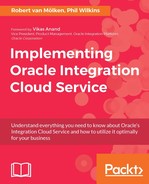In this chapter, we created a request and response integration and then used the request to enrich the response with the original request values. This was then cloned and extended to incorporate an enrichment service that was implemented using a REST-based web service. We then looked at how mapping exploits an additional variable that holds the enrichment data. All forms of enrichment will follow these basic patterns.
Although we used an external web service to perform the enrichment, it would be equally possible to perform the enrichment using another ICS integration, as long as it met the need for a synchronous request and response.
We then enhanced the integration after cloning it again, this time utilizing a lookup mechanism to retrieve additional values related to one of the response object's values to populate another element. We used the lookup to simply enrich our service (so it was possible to see both the original value and the lookup result). But often, the lookup would be doing value substitutions, for example, replacing UK with GB, and so on.
A natural step on from this would be to explore using more advanced XSLT and XQuery operations to complete sophisticated enrichment and data mapping.
In the next chapter, we continue working with Basic Map Data pattern, but to filter events, so that only specific message types can reach a destination based upon the data in the integration. This also leads to routing events to different endpoints, subject to message content.
